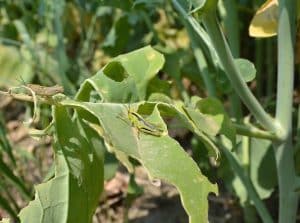Grasshoppers are often worse in hot, dry conditions. One big reason is because insects, as cold-blooded creatures, eat more and grow faster in hot weather. The other reason is that hot, dry weather limits fungal infection, one of the main threats to grasshopper eggs. In dry weather, a larger proportion of eggs hatch.

Thresholds
The nominal threshold for canola is seven to 12 per square metre. This threshold comes from entomology experience from across the Prairies, including from Dan Johnson with the University of Lethbridge.
The higher end of that range may be more appropriate in average or above average growing conditions where grasshoppers have ample food. Given a choice, most grasshopper species prefer grass and cereals to canola. The low end is for dry conditions. Dan Johnson says that well-designed grasshopper research indicated that under certain situations (specifically hot and dry), the grasshopper threshold for canola could be lower than seven to 12 per square metre, perhaps as low as five.
If canola is the only green material nearby, grasshoppers can cause significant damage as they move in from drying pasture, cut hay or a nearby crop that is becoming unpalatable. Damage is typically focused on the field margins, so control can be focused on these areas. A bran bait, EcoBran, is particularly effective on younger grasshoppers and field margins. Consult the label for use rates. Placing a couple pounds per acre of this product gives another line of defense to work against grasshoppers that can aggressive feed under hot dry conditions.
How to count
The challenge with the nominal threshold is counting the grasshoppers. As soon as you walk into an area, grasshoppers take off and do not cooperate with your attempts to count them. So entomologists have come up with more practical scouting techniques.
Technique one:
- Walk across the field. If grasshoppers jump around with every step you take, and seem to be general throughout the field, numbers are probably at the threshold.
- Look for feeding. If there is less crop than there was the last time you checked, and the problem appears to be grasshopper feeding, spraying may be warranted.
- Control grasshoppers when they’re 1/2” long, or so. At this stage, they’re hopping but not flying, and much easier to control. (Note: Synthetic pyrethroids are not particularly effective against winged grasshoppers.)
Technique two was featured in the Prairie Pest Monitoring Network blog:
- Measure off a distance of 50m on the level road surface and mark both starting and finishing points using markers or specific posts on the field margin.
- Starting at one end, either in the field or the roadside, walk toward the other end of the 50m making some disturbance with your feet to encourage any grasshoppers to jump.
- Grasshoppers that jump/fly through the field of view within a one metre width in front of the observer are counted. (A metre stick can be carried as a visual tool to give perspective for a one metre width. However, after a few stops one can often visualize the necessary width and a metre stick may not be required. Also, a hand-held counter can be useful in counting while the observer counts off the required distance.)
- At the end point the total number of grasshoppers is divided by 50 to give an average per square metre.
- Compare counts to the following damage levels associated with pest species of grasshoppers:
- 0-2 per m² – None to very light damage
- 2-4 per m² – Very light damage
- 4-8 per m² – Light damage
- 8-12 per m² – Action threshold in cereals and canola
- 12-24 per m² – Severe damage
- >24 per m² – Very severe damage
Avoid spraying on hot, hot days. At temperatures above 25°C, grasshoppers can metabolize insecticide more quickly, and it can be less effective. Warm, not hot, days result in slower metabolization and better control.
More…
- Canola Encyclopedia chapter on grasshoppers